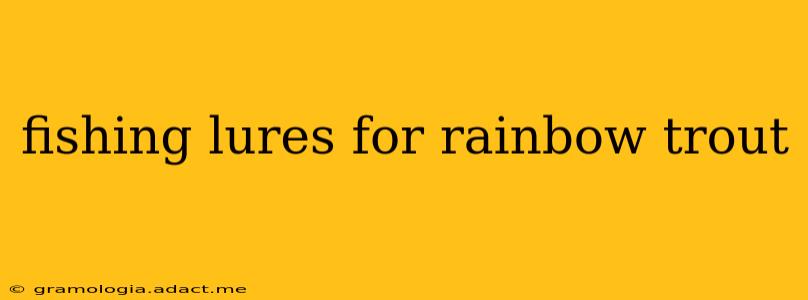Rainbow trout, with their vibrant colors and spirited fight, are a prized catch for anglers worldwide. Choosing the right lure can significantly increase your success rate. This guide explores effective lures for rainbow trout, covering various styles, colors, and techniques. Whether you're fishing in a fast-flowing river or a calm lake, understanding the nuances of lure selection is key to a rewarding fishing experience.
What are the best lures for catching rainbow trout?
The "best" lure is highly dependent on several factors, including the time of year, water conditions (clear, murky, fast, slow), and the trout's behavior. However, some lures consistently perform well:
-
Spoons: These classic lures are incredibly effective. Their shimmering action mimics injured baitfish, triggering a predatory response in trout. Popular choices include Colorado spoons and Kastmaster spoons, available in a wide range of sizes and weights. Experiment with different retrieves – slow, steady retrieves often work best in slower water, while faster retrieves can be more effective in faster currents.
-
Spinners: Similar to spoons, spinners use a rotating blade to create flash and vibration. Inline spinners like the Rooster Tail and Panther Martin are excellent choices, particularly in clear water. The rotating blade attracts trout from a distance, making them ideal for covering water quickly.
-
Crankbaits: These lures dive to specific depths, allowing you to target trout in different water columns. Choose crankbaits with a tight wobble for clear water and a wider wobble for murky water. Experiment with different retrieve speeds and depths to find what works best in your specific fishing location.
-
Hard-bodied Minnows: These lures mimic small baitfish and offer a realistic swimming action. They are particularly effective when trout are feeding on smaller fish. Look for lures with a natural swimming action and a lifelike finish.
-
Soft Plastics: These versatile lures can be rigged in various ways to imitate a variety of baitfish. Small tubes, grubs, and worms are particularly effective, especially when fished slowly near the bottom or along weed beds.
What colors of lures work best for rainbow trout?
Rainbow trout are visually oriented predators, and lure color plays a significant role in their attraction. However, the most effective color varies depending on water clarity and light conditions.
-
Clear Water: In clear water, more natural colors are often best. Think silver, gold, white, and subtle shades of brown and olive.
-
Murky Water: In murky water, brighter colors are more visible and often more effective. Consider using chartreuse, bright orange, pink, or red.
-
Low Light Conditions: During dawn, dusk, or overcast days, brighter, more contrasting colors are preferred.
It's always a good idea to experiment with different colors to see what works best on a given day. Often, subtle variations in shade can make a big difference.
What size lures are best for rainbow trout?
The ideal lure size depends on the size of the trout you're targeting and the available forage. A good starting point is to use lures that are approximately 1/3 to 1/2 the length of the average trout you expect to catch. In general, smaller lures are better for smaller trout, while larger lures are better for larger trout.
What type of fishing line should I use with lures for rainbow trout?
Using the right line is crucial for successful rainbow trout fishing. Typically, 4- to 6-pound test monofilament or fluorocarbon line is a good choice for most situations. Fluorocarbon is less visible in the water and offers better sensitivity, allowing you to detect subtle strikes. Braided line can also be used, but a fluorocarbon leader is usually recommended to improve stealth.
How do I retrieve lures effectively for rainbow trout?
The best retrieve depends on the specific lure and the conditions. Experimentation is key! Try a variety of retrieves, including:
- Slow and steady: Ideal for attracting trout that are not actively feeding.
- Fast and erratic: Effective for triggering strikes from aggressive trout.
- Stop and go: Pause the retrieve periodically to create a sense of urgency.
- Twitching and jerking: Imitates an injured baitfish.
Are there any other factors I should consider when choosing lures for rainbow trout?
Beyond the type, color, and size of the lure, several other factors influence your success:
-
Water Depth: Consider using lures that dive to the appropriate depth for the trout you're targeting.
-
Current: In fast-flowing rivers, heavier lures with a strong action are often more effective. In slow-moving water, lighter lures with a more subtle action might be better.
-
Season: Trout's feeding habits change throughout the year. Adjust your lure selection accordingly.
By understanding these factors and experimenting with different techniques, you can significantly improve your chances of catching rainbow trout. Remember, patience and persistence are key to success!
